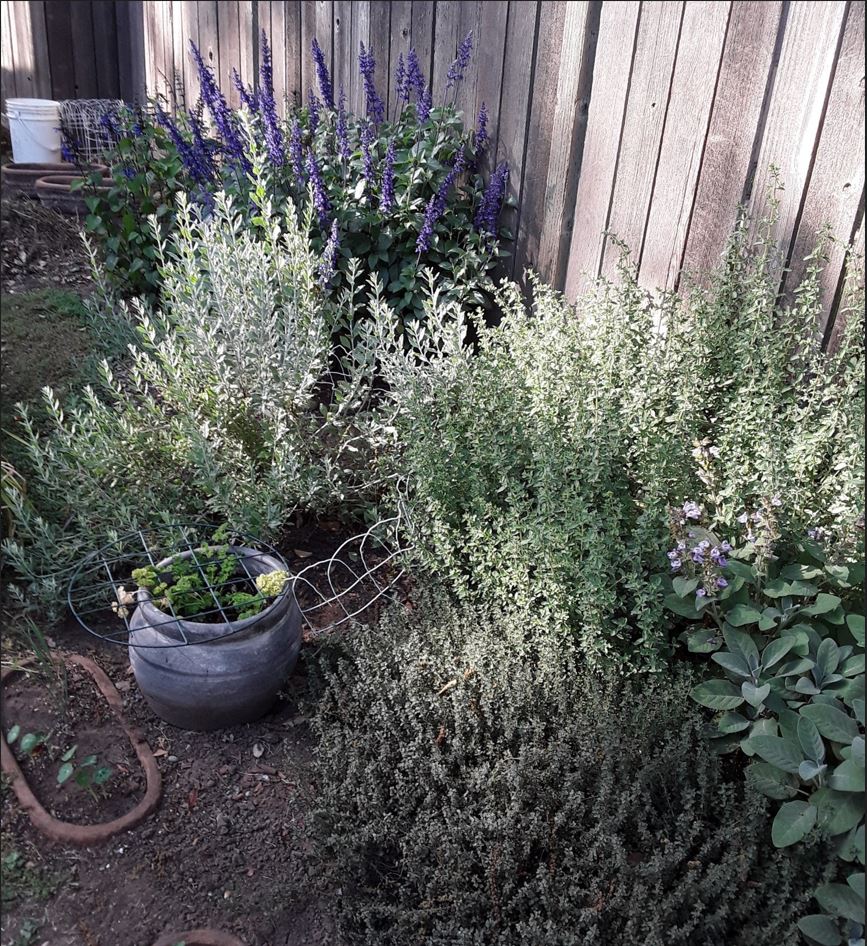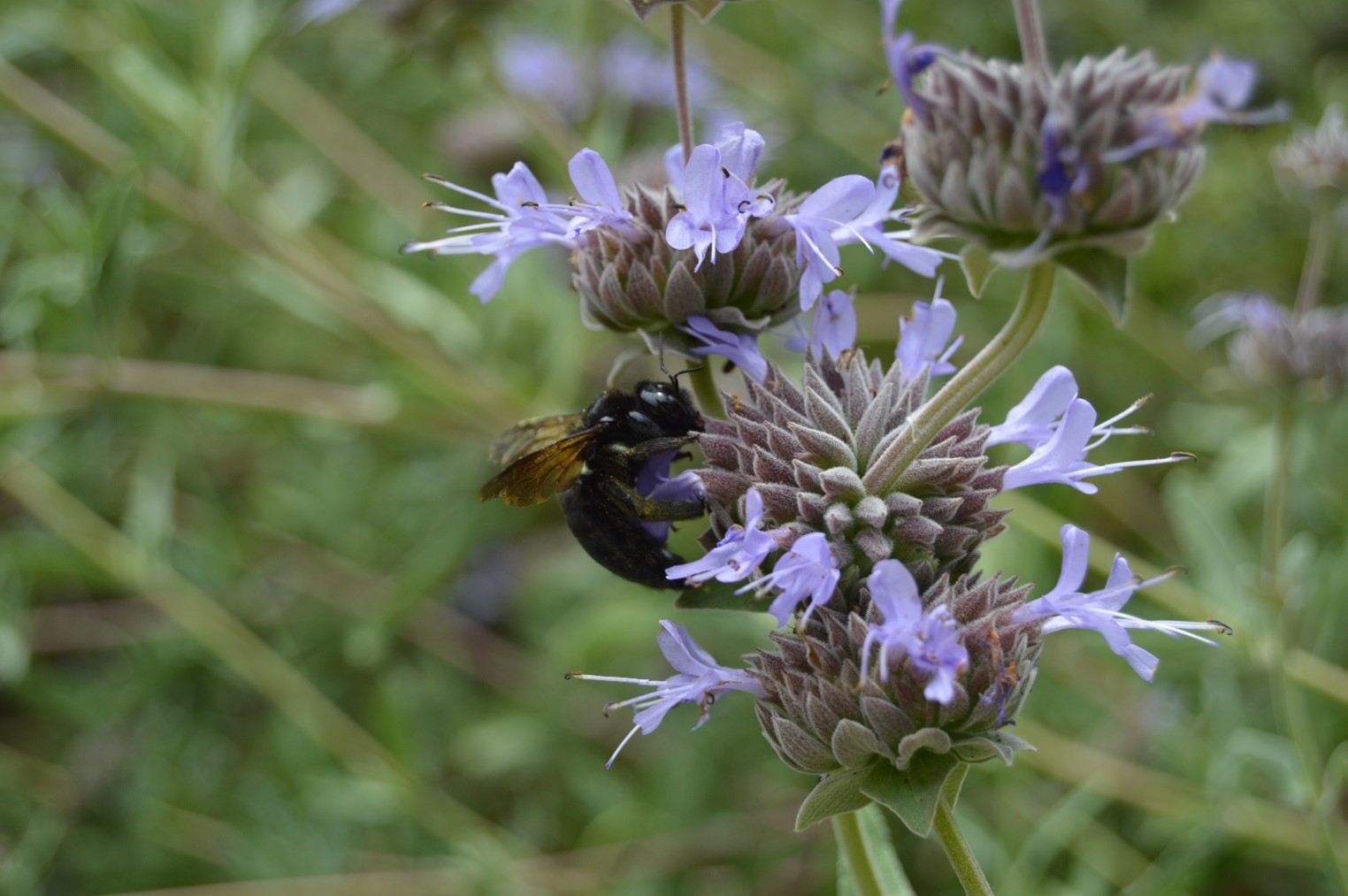Fall 2022
Sustainability from the Bottom up
By Jackie Howland

Jackie’s collection of pollinator-attracting herb plants in her home garden.
This is the second in a series on sustainability. Since I wrote about last time, it’s only fitting that I write on the creatures that are responsible for much of that food. These are pollinators, of course.
While some plants such as grasses and grains are pollinated by the wind, the vast majority of the foods we get from plant sources depend on insect pollination. It’s estimated that every third bite we eat is the result of pollinators, so anything we do to help them can only help us. And we as individuals can do a lot.
You’re no doubt familiar with honeybees and know how important they are in agriculture. Indeed, they’ve been helping farmers for far longer than they were kept by humans. Honeybees appear to have originated in Asia about 100 million years ago, coinciding with the development of flowering plants. Humans have been keeping them for about 8,500 years, but we began farming around 12,000 years ago. Bees and other pollinators naturally made use of our efforts on their own (and some still do) because it benefitted them.
The world of pollinators is much more complex than honeybees, though. This shouldn’t be surprising – if one species began exploiting a food source, then it only follows that other species would use this resource too. And of course, the original pollinator species would split into other species and so on. There are over 1,600 species of bees in California alone. Then there are butterflies, moths, hummingbirds, bats, beetles, some wasps and even some flies! These creatures all contribute to the rich biodiversity we have today, not to mention the complex food web. Helping pollinators not only helps us, it helps other animals and plants. I can give you a personal example from my own backyard.
I decided to plant my pollinator garden a few years ago after trying to grow tomatoes. Plenty of blooms, but no tomatoes. At that time, the only thing growing in the yard were a few non-native shrubs and plenty of weeds. I added a blue salvia (shown blooming in the photo) , Russian sage, culinary sage, oregano, thyme, and another plant for the hummingbirds. Within a few weeks, I had tomatoes set on the vine. Too bad that was in November.
Three years later, all those plants have grown enormously. I now have many pollinators visiting them and an increase in other creatures as well. I’m seeing more lizards, for one, because of course there are more insects for them to hunt and more places to hide. I also disturbed a toad a few weeks ago, which was hiding in the soft soil around the plants – they bury themselves during the day to stay moist and cool and they’ll also do this over the winter when insects aren’t available. Before I planted my pollinator garden, the dirt was too hard for this. Now the plants are dropping leaves which decay and feed insects and microorganisms and change the whole aspect of the ecosystem.
Being a nerd, I love trying to identify what pollinators are visiting. Of course, the honeybees are easy, and they love the salvia and the oregano. Carpenter bees, which also love the salvia, are another easy species to identify. The females are solid black, chunky and can be as long as an inch and a quarter. I’ve developed a pet peeve now – not directed at carpenter bees. It’s about all the ads for pest control that pop up when I’m looking for information on them. People really need to understand that these bees don’t eat wood. They nest in wood, but only the untreated kind. They’re a minor pest in the eastern US and there it takes decades for them to do serious damage to support beams. (The nest holes keep getting used by generations of bees.) But the same steps we take to protect wood from termite damage – paint, shellac, or chemical treatment – will also prevent carpenter bee nesting.
Sometimes people assume carpenter bees are bumble bees, especially if they have yellow pollen stuck to them. They are very different bees though, in size, coloring, nesting choice and lifestyle. Carpenter bees are solitary while bumble bees are social, much like honeybees. Bumble bees make their nests in the ground, so they need bare, undisturbed soil. One important aspect of helping pollinators can be to leave things as nature made them. The use of native plants is essential for some species, so planting them or leaving the “weeds” alone is a must. At least in some areas of the back yard, let nature do her thing.
The front yard can also be a haven for pollinators and still be attractive. Reducing or even eliminating lawn and replacing it with plants that are more adapted to our dry summers not only helps pollinators but will also lower your water bill and reduce our depletion of the aquifer, that underground source of water that is essential for us and for native plants. These plants are adapted to our climate, but
a big part of that adaptation is sending their roots deep down in search of ground water. We’re depleting this source in large part by constantly watering non-native crops, grasses and shrubs that are adapted to year-round rains. People can do many things with their front yard that isn’t about lawn. In addition to native plants, I especially notice the yards with vegetables, fruiting vines, dwarf fruit trees and herbs, but I also notice things like palm trees and sand! Schools that have flowers and vegetable gardens help kids understand where these resources come from before they get to the store. It’s also essential that we all understand we can’t have fruits and vegetables without pollinators. Just so you know, Gateway is planning an exhibition on bumblebees, so feel free to donate money toward making that happen!
On something of a side note, I wasn’t getting very many tomatoes while it was really hot, but since we had that good rain and it’s cooled down, the plants have gone rather crazy fruiting. Maybe the pollinators go up to the mountains during really hot weather and return when it cools down. We do need more research on these valuable creatures! It might be time to enlist average people to do some pollinator-watch activities as has been done with birds. If you do nothing else, at least plant a flower or two. They bring joy to people and pollinators alike.

Female valley carpenter bee (Xylocopa varipuncta) visiting Cleveland sage (Salvia clevelandii) in Gateway Gardens.
